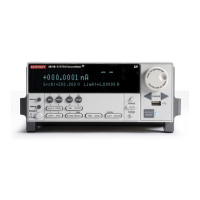12-116 Return to Section Topics 2600S-901-01 Rev. C / January 2008
Section 12: Instrument Control Library Series 2600 System SourceMeter® Instruments Reference Manual
userstring functions
The functions in this group are used to store/retrieve user-defined strings in non-volatile memory.
tsplink.writeport
Function Writes to all TSP-Link synchronization lines.
Usage tsplink.writeport(data)
data Value to write to the port; 0 to 7.
Remarks • The binary representation of data indicates the output pattern to be written to the I/O port.
For example, a data value of 2 has a binary equivalent of 010. Line 2 is set high (1), and
the other 2 lines are set low (0).
• Write protected lines will not be changed (see tsplink.writeprotect).
• The reset function does not affect the present states of the digital I/O lines.
• Use the tsplink.writebit and tsplink.writeport commands to control the
output state of the synchronization line while the trigger mode is set to
tsplink.TRIG_BYPASS.
Details See “Controlling digital I/O lines” in Section 10.
Also see tsplink.readbit, tsplink.readport, tsplink.writebit.
Example Sets the synchronization lines 1 and 2 high (binary 011):
tsplink.writeport(3)
tsplink.writeprotect
Attribute Write protect mask that disables bits from being changed with the tsplink.writebit
and
tsplink.writeport functions.
Usage mask = tsplink.writeprotect -- Reads write protect mask.
tsplink.writeprotect = mask -- Writes write protect mask.
mask --Set to the value that specifies the bit pattern
for write protect.
Remarks • Bits set to 1 cause the corresponding line to be write protected.
• The binary equivalent of mask indicates the mask to be set for the I/O port. For example,
a mask value of 5 has a binary equivalent 101. This mask write protects lines 1 and 3.
Details See “Controlling digital I/O lines” in Section 10.
Also see tsplink.readbit, tsplink.readport tsplink.writeport
Example Write protects lines 1 and 3:
tsplink.writeprotect = 5
userstring.add
Function Adds a user-defined string to non-volatile memory.
Usage userstring.add(name, value)
name The name for the string.
value The string to associate with the name.
Remarks This function will associate the string value with the string name and store the pair in
non-volatile memory. The value associated with the given name can be retrieved with
the
userstring.get function.
Also see userstring.catalog, userstring.delete, userstring.get
Example Stores user-defined strings in non-volatile memory:
userstring.add("assetnumber", "236")
userstring.add("department", "Widgets")
userstring.add("contact", "John Doe")

